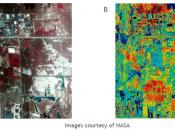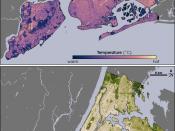Enviromental problem that little is spoken about. Good Job, interesting subject
Urban Heat Islands
For more than 100 years, it has been known that two adjacent cities are generally warmer than the surrounding areas. This region of city warmth, known as an urban heat island, can influence the concentration of air pollution. The urban heat island is formed when industrial and urban areas are developed and heat becomes more abundant. In rural areas, a large part of the incoming solar energy is used to evaporate water from vegetation and soil. In cities, where less vegetation and exposed soil exists, the majority of the sun's energy is absorbed by urban structures and asphalt. Hence, during warm daylight hours, less evaporative cooling in cities allows surface temperatures to rise higher than in rural areas. Additional city heat is given off by vehicles and factories, as well as by industrial and domestic heating and cooling units.
At night, the solar energy, which is stored as vast quantities of heat in city buildings and roads, is released slowly into the city. The dissipation of heat energy is slowed and even stopped by the tall building walls that do not allow infrared radiation to escape as readily as do the relative level surfaces of the surrounding countryside. The slow release of heat tends to keep city temperatures higher than those of the unpaved faster cooling areas.
On clear, still nights when the heat island is pronounced, a small thermal low-pressure area forms over the city. Sometimes a light breeze, called a country breeze which blows from the countryside into the city. If there are major industrial areas along the city's outskirts, pollutants are carried into the heart of town, where they tend to concentrate.
At night, the extra warmth of the city occasionally...


